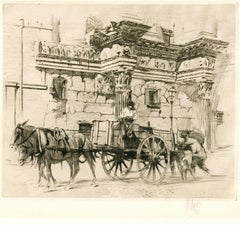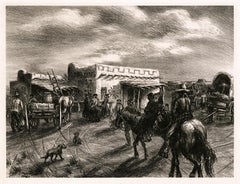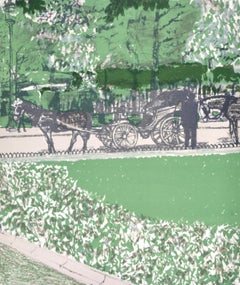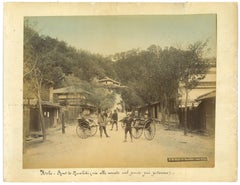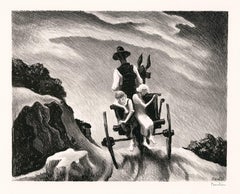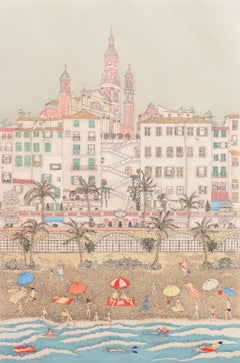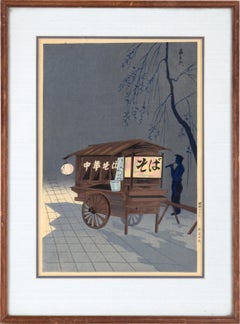Wagon Landscape Prints
to
1
4
1
1
Overall Width
to
Overall Height
to
3
1
1
1
1
1
5
1
1
1
5
1
100
7,483
3,764
3,156
2,308
1,831
1,698
1,657
1,624
1,572
1,182
1,077
1,004
981
878
827
728
586
532
519
4
3
1
1
1
4
2
Art Subject: Wagon
A Kodak Moment
Located in San Francisco, CA
This artwork titled "A Kodak Moment" 1992 is an offset lithograph by renown Western artist Gary Carter, born 1938. It is hand signed and numbered 816/850 i...
Category
Late 20th Century American Realist Figurative Prints
Materials
Lithograph
Forum of Minerva, Assisi, Italy
Located in Middletown, NY
Etching with aquatint on watermarked F J Head & Co. cream laid paper, 9 3/4 x 11 1/2 inches (245 x 290 mm), full margins. Signed in pencil, lower margin. Scattered age tone and mat t...
Category
Early 20th Century Modern Landscape Prints
Materials
Laid Paper, Etching, Aquatint
'Navajo Trading Post' — Southwest Regionalism, American Indian
Located in Myrtle Beach, SC
Ira Moskowitz, 'Navajo Trading Post', lithograph, 1946, edition 30, Czestochowski 161. Signed and dated in the stone, lower left. A fine, richly-inked impression, on cream wove paper, with full margins (1 1/2 to 3 1/8 inches). Pale mat line, otherwise in excellent condition. Matted to museum standards, unframed.
Image size 11 11/16 x 15 1/2 inches (297 x 395 mm); sheet size 16 5/16 x 191/8 inches (414 x 486 mm).
ABOUT THE ARTIST
Ira Moskowitz was born in Galicia, Poland, in 1912, emigrating with his family to New York in 1927. He enrolled at the Art Student's League and studied there from 1928-31. In 1935, Moskowitz traveled to Paris and then lived until 1937 in what is now Israel. He returned to the United States in 1938 to marry artist Anna Barry in New York. The couple soon visited Taos and Santa Fe in New Mexico, returning for extended periods until 1944, when they moved there permanently, staying until 1949. During this especially productive New Mexico period, Moskowitz received a Guggenheim fellowship. His work was inspired by the New Mexico landscape and the state’s three cultures (American Southwest, Native American, and Mexican). He focused on Pueblo and Navajo life, producing an extensive oeuvre of authentic American Indian imagery. He and Anna also visited and sketched across the border in Old Mexico. While in the Southwest, Moskowitz flourished as a printmaker while continuing to produce oils and watercolors. Over 100 of Moskowitz’s works depicting Native American ceremonies were used to illustrate the book American Indian Ceremonial Dances by John Collier, Crown Publishers, New York, 1972.
After leaving the Southwest, printmaking remained an essential medium for the artist while his focus changed to subject matter celebrating Judaic religious life and customs. These works were well received early on, and Moskowitz was content to stay with them the rest of his life. From 1963 until 1966, Moskowitz lived in Paris, returning to New York City in 1967, where he made his permanent home until he died in 2001.
Shortly before his death, Zaplin-Lampert Gallery of Santa Fe staged an exhibition of the artist's works, December 2000 - January 2001. Other one-person shows included the 8th Street Playhouse, New York, 1934; Houston Museum, 1941; and the San Antonio Museum, 1941. The artist’s work was included in exhibitions at the Art Students League, Art Institute of Chicago, Philadelphia Print Club, College Art Association (promotes excellence in scholarship and teaching), and the International Exhibition of Graphic Arts (shown at MOMA, 1955).
Moskowitz’s lithographs of American Indian...
Category
1940s American Modern Landscape Prints
Materials
Lithograph
La Calèche dans le parc, Regards sur Paris, Maurice Brianchon
Located in Auburn Hills, MI
Lithograph on vélin d’Arches paper. Inscription: unsigned and unnumbered, as issued. Good condition. Notes: from the folio, Regards sur Paris, 1962. Published by André Sauret, Paris;...
Category
1960s Modern Landscape Prints
Materials
Lithograph
Before the Trotting Race - Original Lithograph Handsigned Numbered
By Yves Brayer
Located in Paris, IDF
Yves Brayer (1907-1990)
Before the Trotting Race
Original lithograph, c.1973
Handsigned in pencil by the artist
Numbered /250 copies
Size 50 x 65 cm, on Arches Vellum
Information: ...
Category
1970s Landscape Prints
Materials
Vellum, Lithograph
Ancient Views of Kobe - Vintage Albumen Print - 1890s
Located in Roma, IT
Ancient Views of Kobe is an original vintage albumen print on single cardboard: 26 x 34 cm.
They were realized in the 1890s.
Good conditions e...
Category
Late 19th Century Figurative Prints
Materials
Cardboard, Photographic Paper
Related Items
'Goin' Home' — WPA Era American Regionalism
Located in Myrtle Beach, SC
Thomas Hart Benton, 'Goin' Home', lithograph, 1937, edition 250, Fath 14. Signed in pencil. Signed in the stone, lower right. A fine, richly-inked impression, on off-white, wove paper, with margins, in excellent condition. Published by Associated American Artists. Archivally matted to museum standards, unframed.
Image size 9 7/16 x 11 7/8 inches; sheet size 10 3/4 x 13 5/16 inches.
Impressions of this work are held in the following museum collections: Figge Art Museum, Georgetown University Art Collection, Indianapolis Museum of Art, Library of Congress, Metropolitan Museum of Art, and the Nelson-Atkins Museum of Art.
ABOUT THE ARTIST
“Benton’s idiom was essentially political and rhetorical, the painterly equivalent of the country stump speeches that were a Benton family tradition. The artist vividly recalled accompanying his father, Maecenas E. Benton — a four-term U.S. congressman, on campaigns through rural Missouri. Young Tom Benton grew up with an instinct for constituencies that led him to assess art on the basis of its audience appeal. His own art, after the experiments with abstraction, was high-spirited entertainment designed to catch and hold an audience with a political message neatly bracketed between humor and local color.”
—Elizabeth Broun “Thomas Hart Benton: A Politician in Art,” Smithsonian Studies in American Art, Spring 1987.
Born in 1889 in Neosho, Missouri, Thomas Hart Benton spent much of his childhood and adolescence in Washington, D.C., where his father, Maecenas Eason Benton, served as a Democratic member of Congress from 1897 to 1905. Hoping to prepare Benton for a political career, his father sent him to Western Military Academy. After nearly two years at the academy, Benton persuaded his mother to support him in attending the Art Institute of Chicago for two years, followed by two additional years at the Académie Julian in Paris.
In 1912, Benton returned to America and moved to New York to pursue his artistic career. One of his first jobs involved painting sets for silent films, which were being produced in Fort Lee, New Jersey. Benton credits this experience with equipping him with the skills necessary to create his large-scale murals.
When World War I broke out, Benton joined the Navy. Stationed in Norfolk, Virginia, he was assigned to create drawings of camouflaged ships arriving at Norfolk Naval Station. These renderings were used to identify vessels that might be lost in battle. Benton later remarked that being a "camofleur" profoundly impacted his career: "When I came out of the Navy after the First World War," he said, "I made up my mind that I wasn’t going to be just a studio painter, a pattern maker in the fashion then dominating the art world—as it still does. I began to think of returning to the painting of subjects, subjects with meanings, which people, in general, might be interested in."
While developing his Regionalist vision, Benton also taught art, first at a city-supported school and later at The Art Students League from 1926 to 1935. One of his students was a young Jackson Pollock, who regarded Benton as both a mentor and father figure. In 1930, Benton was commissioned to paint a mural for the New School for Social Research. The "America Today" mural, now permanently exhibited at the Metropolitan Museum of Art, led to many more commissions as Benton’s work gained wide recognition.
The Regionalist Movement became popular during the Great Depression of the 1930s. Painters such as Benton, Grant Wood, and John Steuart Curry rejected modernist European influences, choosing instead to depict realistic images of small-town and rural life—comforting representations of the American heartland during a period of upheaval. Time Magazine referred to Benton as "the most virile of U.S. painters of the U.S. Scene," featuring his self-portrait on the cover of a 1934 issue that included a story titled "The Birth of Regionalism."
In 1935, Benton left New York and returned to Missouri, where he taught at the Kansas City Art Institute. His outspoken criticism of modern art, art critics, and political views alienated him from many influential figures in both political and art circles. Nonetheless, Benton remained true to his beliefs, continuing to create murals, paintings, and prints that captured enduring images of American life. The dramatic and engaging characteristics of Benton’s artwork drawn the attention of Hollywood producers, leading him to create illustrations and posters for films, including his famous lithographs for the film adaptation of John Steinbeck’s "The Grapes of Wrath," produced by Twentieth Century Fox.
During the 1930s, The Limited Editions Club of New York asked Benton to illustrate special editions of three of Mark Twain’s books...
Category
1930s American Realist Figurative Prints
Materials
Lithograph
'Beach at Menton', Paris, Ecole des Beaux-Arts, New York, Woman Artist, Madrid
By Cuca Romley
Located in Santa Cruz, CA
Signed, lower right, in pencil, 'Cuca Romley' (Spanish, born 1933), titled 'Plage de Menton' lower center and inscribed, lower left, with number and limitation, '77/175'.
An elegant view of this famous resort town in the South of France with bathers and holiday makers seen on the beach and a view beyond to the famous 17th century, baroque Basilica of St. Michael.
Born in Madrid, Cuca Romley studied at the Ecole des Beaux-Arts in Paris. Over the course of a long career, she has exhibited internationally with success including at the Salon Nacional de Dibujos de Alta Costura...
Category
Late 20th Century Modern Landscape Prints
Materials
Laid Paper, Etching
Wyeth, Brinton’s Mill, The Four Seasons (after)
By Andrew Wyeth
Located in Auburn Hills, MI
Lithograph on vélin paper. Unsigned and unnumbered, as issued. Good condition. Published and printed by Art in America, New York in an edition of CDVII/D. From the folio, The Four Se...
Category
1960s American Realist Figurative Prints
Materials
Lithograph
Wyeth, Early October, The Four Seasons (after)
By Andrew Wyeth
Located in Auburn Hills, MI
Lithograph on vélin paper. Unsigned and unnumbered, as issued. Good condition. Published and printed by Art in America, New York in an edition of CDVII/D. From the folio, The Four Se...
Category
1960s American Realist Figurative Prints
Materials
Lithograph
Wyeth, New Leaves, The Four Seasons (after)
By Andrew Wyeth
Located in Auburn Hills, MI
Lithograph on vélin paper. Unsigned and unnumbered, as issued. Good condition. Published and printed by Art in America, New York in an edition of CDVII/D. From the folio, The Four Se...
Category
1960s American Realist Figurative Prints
Materials
Lithograph
Birds on Branches - Lithograph in Ink on Paper - Edition of 75
Located in Soquel, CA
Birds on Branches - Lithograph in Ink on Paper - Edition of 75
Delicate and detailed lithograph of birds by Fugi Nakamizo (Japanese/American, 1889-1950)...
Category
Early 20th Century Impressionist Animal Prints
Materials
Paper, Ink, Lithograph
H 14.75 in W 19.75 in D 0.38 in
'Plowing It Under' — WPA Era American Regionalism
Located in Myrtle Beach, SC
Thomas Hart Benton, 'Goin' Home', lithograph, 1937, edition 250, Fath 14. Signed in pencil. Signed in the stone, lower right. A fine, richly-inked impression, on off-white, wove pape...
Category
1930s American Realist Figurative Prints
Materials
Lithograph
Wyeth, The Corner, The Four Seasons (after)
By Andrew Wyeth
Located in Auburn Hills, MI
Lithograph on vélin paper. Unsigned and unnumbered, as issued. Good condition. Published and printed by Art in America, New York in an edition of CDVII/D. From the folio, The Four Se...
Category
1960s American Realist Figurative Prints
Materials
Lithograph
Original Remember Your First Thrill of American Liberty 1917 vintage poster
Located in Spokane, WA
Original poster: Rembember Your First Thrill of Ameridan Liberty YOUR DUTY Buy United States Government Bonds 2nd Liberty Loan of 1917. Linen backed and ready to frame. Poste...
Category
1910s American Realist Figurative Prints
Materials
Lithograph
H 30 in W 20 in D 0.2 in
Put Fighting Blood in Your Business
Located in Spokane, WA
Original WW1 poster. Put Fighting Blood in Your Business. Here’s his record! Does he get a Job? Arthur Woods, Assistant to the Secretary of...
Category
1910s American Realist Landscape Prints
Materials
Lithograph
Original "Food Will Win The War" vintage World War 1 poster
Located in Spokane, WA
Original World War 1 vintage poster: Food Will Wn the War. Arhival linen backed. PRINTER: Rusling Wood Litho., New York Bright and in good condition. There is some marks down the left side of the poster, possible ink from when the poster was printed.
This poster calls on immigrants to do their part in the war effort. It depicts recent immigrants standing near a sailing ship with the Statue of Liberty and a rainbow stretched across the New York City skyline in the background. The text reads:
You came here seeking Freedom.
You must now help preserve it.
Wheat is needed by the allies.
Waste nothing.
The generosity and compassion of the American people and the great agricultural resources of the North American continent would be called upon... Twenty million Americans signed pledges of membership in the Food Administration...
Category
1910s American Realist Figurative Prints
Materials
Lithograph
H 30 in W 20 in D 0.05 in
Bowling on the Green (from the Bicentennial Pageant of George Washington)
Located in Soquel, CA
Bowling on the Green (from the Bicentennial Pageant of George Washington)
'Bowling on the Green', by printmaker Frederick Childe Hassam, depicts George Washington and friends lawn b...
Category
1930s American Impressionist Figurative Prints
Materials
Ink, Etching, Laid Paper
H 16 in W 20 in D 0.25 in
Previously Available Items
Soba Noodle Vendor Cart at Night - Japanese Woodblock in Ink on Paper
Located in Soquel, CA
Soba Noodle Vendor Cart at Night - Japanese Woodblock in Ink on Paper
Clean and balanced depiction of noodle cart by Tomikichiro Tokuriki (Japanese, 1902-1999). The noodle cart is front and center, in full color, with a faint glow emanating from the sign. The vendor is standing silhouetted to the right of the cart, under a wispy tree.
Artist's signature along the right edge.
Signature in the upper right corner.
Presented in a wood frame with a light blue grey mat.
Frame size: 19.75"H x 14.5"W
Paper size" 15.38"H x 10.25"W
Tomikichiro Tokuriki (Japanese, 1902-1999) was born March 22, 1902, in Kyoto, Japan. The first teacher of the young Tomikichiro was his grandfather. Later he entered the Kyoto School of Arts and Crafts with a two-year preparatory class and four years of regular training, and later a three year training at the Kyoto College of Art. He graduated from Kyoto Art College in 1923.
While still at college, the young artist discovered his passion for sosaku hanga prints - a movement that had spread from Tokyo to Kyoto. With the assistance of an old carver and an Ukiyo-e printer, Tomikichiro Tokuriki learned everything to master the complete process of design, carving and printing himself.
While the artist published his creative hanga-style prints himself, the artisan-prints were published by Uchida, Unsodo and other Kyoto publishers.
Later he joined the Hanga Association and met other artists of the sosaku hanga movement like Hiratsuka, Masao Maeda, Kihachiro Shimozawa, Hide Kawanishi and Shiko Munakata.
Like so many Japanese artists of the twentieth century, he went on extensive travels throughout Europe and the United States. In the sixties, he opened several exhibitions of his artworks in major US cities like Chicago, New York, Pittsburgh and Cleveland. And of course, he used his trips abroad to make sketches.
Tokuriki Tomikichiro...
Category
1950s Edo Figurative Prints
Materials
Paper, Ink, Woodcut
H 19.75 in W 14.5 in D 0.5 in
